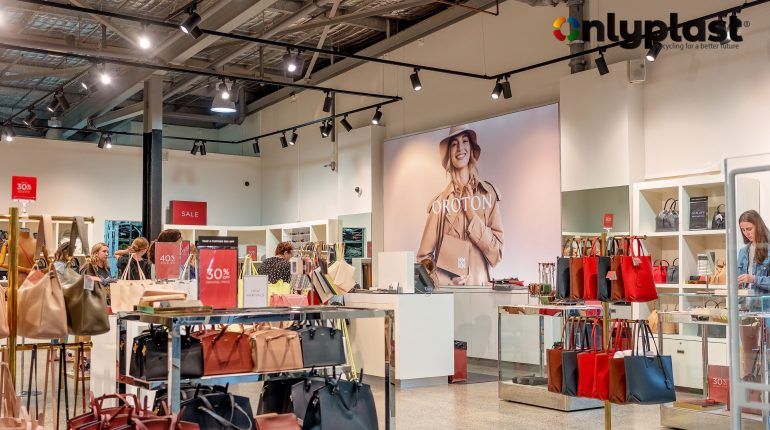Fashion and the circular economy: a challenge that has not yet an end
There are two determining factors that keep making it difficult for the circular economy to make headway in the fashion industry: greenwashing and the lack of knowledge. We analyse the key points in this article.
- The Consumer:
The pandemic has clearly marked a turning point in consumer attitudes. It seemed that the use of recycled plastics could have gone backwards during tha pandemic, but nothing could be further from the current situation. The evidence of climate change, the legal age of Generation Z and the communication actions driven by activists, NGOs, opinion leaders, scientists, institutions and organisations are shaping the demands of an increasingly engaged consumer.
All this is reflected in the environmental commitment that customers expect from companies through their CSR policies and even in the process of manufacturing, packaging and distribution of the product.
However, something is happening with the fashion industry. It seems that these demands are not being passed on to the firms that market clothing. Why is this happening?
- The “fast fashion” concept hastened by the speed of social networks and the emergence of online shops.
In the 1970s, polyester made its way into clothing. This meant a certain “democratisation” of fashion, as well as the emergence of the “fast fashion” concept.In recent years, especially due to the rise of social media, fashion collections are increasingly ephemeral and trends change at the speed at which a person can share a story or a short film.
Plastic allows consumers to keep going further. If the arrival of polyester made fashion an accesible concept in the 1970s, now it facilitates impulse buying and the arrival of the throw away culture in young people’s clothes.
However, considering the introduction of this article and the characteristics of Generation Z itself, there is a point of discrepancy between the values of the Generation, linked to a strong environmental commitment, and the relationship of young people with fashion. Why is this happening?
- Greenwashing and lack of knowledge
The Fast Fashion’s Plastic Problem study, carried out in the UK, shows that there is an awareness gap regarding the amount of plastic in clothing, especially among young people.
In addition to this, many operators have not yet transferred the offer of products made from materials such as r-PET to all their collections. In general, fashion companies take advantage of the large number of online orders they receive and postpone the introduction of materials based on the circular economy. This is because the demand is particularly good and these companies are waiting for a real change in consumer trends, leaving aside the opportunity to be pioneers.
Unfortunately, it is a general practice for many operators to display small collections of r-PET garments as a banner for their companies and their own online shops, even though these collections only make up a small percentage of their offer. This is what is called greenwashing.
Through these greenwashing techniques some operators put the spotlight on these sustainable collections contributing to the confusion of the consumer who logically takes this minimal amount for a whole.
- Committed companies contribute to consumer education as part of their CSR policies.
Thankfully, there are companies that are getting it right. Some were born years ago and some came out of nowhere championing the values of the circular economy and others, including large operators, are gradually joining the trend.
The companies that have invested their resources in the circular economy are the ones that, with concise messages, will make their efforts known, as well as their differentiation with respect to other firms.
It remains to be seen if, in addition to the effort to replace virgin polyester with r-PET, these companies begin to develop awareness campaigns that allow a more sustainable use of fashion, giving clothing a longer life time. This time could help to increase the price of the garments and to give value to r-PET, as well as to create new parallel businesses in which the garments themselves could have a second life as a common practice and accepted by society as a whole.
Fortunately, if there is one thing that characterises the younger generation it is their access to information and their high level of engagement, as well as their listening to activists and organisations, so we hope that the days of greenwashing are numbered.
At Onlyplast, we are dedicated to the sale of recycled plastics. We have been exporting globally for many years and are proud to be a key part of the circular economy. We regularly research the recycled plastics sector: the application to new sectors, products and innovation in the sector itself.
Onlyplast also study the position taken by companies, governments and institutions, as well as their impact on society. Then, we share all these ideas with you in our blog, so you can keep up to date with the latest trends.
Moda y economía circular: una apuesta que no acaba de culminar
Desconocimiento y greenwashing son dos factores determinantes para que la economía circular no acabe de abrirse camino en la industria de la moda. En este artículo analizamos los puntos clave.
- El Consumidor:
La pandemia ha marcado un evidente punto de inflexión respecto a la actitud del consumidor. Durante la pandemia parecía que se hubiese podido retroceder en cuanto al uso de plásticos reciclados; pero nada más lejos de la situación actual. Las evidencias del cambio climático, la mayoría de edad de la Generación Z, y las acciones de comunicación impulsadas por activistas, ONGS, líderes de opinión, científicos, instituciones y organizaciones están acabando de dar forma a las exigencias de un consumidor cada vez más comprometido. Todo esto se traslada en el compromiso medioambiental que el cliente espera de las compañías a través de sus políticas de RSC e incluso en el proceso de fabricación, envasado y distribución del producto.
No obstante, algo está ocurriendo con la industria de la moda. Al parecer, estas exigencias no se están viendo trasladadas hacia las firmas que comercializan prendas de vestir. ¿Por qué está ocurriendo esto?
- El concepto “fast fashion” acelerado por la rapidez de las redes sociales y la aparición de las tiendas online.
En los años 70 el poliéster llegó a las prendas de vestir. Esto supuso una cierta “democratización” de la moda, así como la aparición del concepto “fast fashion”. En los últimos años, especialmente debido al auge de redes sociales, las colecciones de moda son cada vez más efímeras y las tendencias cambian a la velocidad a la que una persona puede compartir un “story” o short. El plástico permite a los consumidores seguir yendo más allá. Si en los años 70 la llegada del poliéster hizo de la moda un concepto accesible, ahora facilita la compra por impulso y la llegada del concepto de “usar y tirar” en las prendas de los más jóvenes.
Pero, atendiendo a la introducción de este artículo y a las características de la propia Generación Z, existe un punto de discrepancia entre los valores de la generación, vinculada a un fuerte compromiso medioambiental, y la relación de los jóvenes con la moda. ¿Por qué ocurre esto?
- Greenwashing y desconocimiento.
El estudio Fast Fashion’s Plastic Problem, realizado en UK, pone de manifiesto que existe una brecha de concienciación en cuanto a la cantidad de plástico que contiene la ropa, especialmente en los jóvenes.
A esto unimos el hecho de que muchos operadores aún no han trasladado la oferta de productos realizados con materiales como r-PET a todas sus colecciones. En general, las firmas de moda se aprovechan de la gran cantidad de pedidos que reciben a nivel online y posponen la introducción de materiales basados en la economía circular, ya que la demanda es especialmente buena y esperan a que se produzca un cambio real en las tendencias de consumo dejando a un lado la oportunidad de ser pioneras.
Lamentablemente, es una práctica general que muchos operadores muestren pequeñas colecciones de prendas realizadas con r-PET como estandarte de sus compañías y de las propias shops online, cuando las mismas solamente suponen un pequeño porcentaje de su oferta. Esto, es una acción de greenwashing.
Mediante estas técnicas de greenwashing algunos operadores ponen el foco en estas colecciones sostenibles contribuyendo a la confusión del consumidor que lógicamente toma esta mínima cantidad por un todo.
- Las empresas comprometidas contribuyen a la educación del consumidor dentro de sus políticas de RSC.
Afortunadamente, sí existen compañías que lo están haciendo bien. Algunas nacieron hace años o bien aparecen de cero defendiendo los valores de la economía circular y otras, incluyendo otros grandes operadores, se incorporan poco a poco a esta tendencia.
Son las propias compañías que han invertido sus recursos en la economía circular las que, con mensajes concisos, se encargarán de hacer saber su esfuerzo, así como su diferenciación respecto a otras firmas. Está por ver si además de al esfuerzo por sustituir el poliéster virgen por r-PET, estas compañías comienzan a desarrollar campañas de concienciación que permitan un uso más sostenible de la moda, dotando a las prendas de un tiempo de vida más prolongado. Este tiempo de vida más prolongado podría ayudar a incrementar el precio de las prendas y a poner en valor el r-PET, a la par que a crear nuevos negocios paralelos en los que las propias prendas puedan tener una segunda vida como una práctica común y aceptada por toda la sociedad.
Afortunadamente, si algo caracteriza a las generaciones más jóvenes es su acceso a la información y su alto compromiso, a la vez que la escucha a activistas y organizaciones, por lo que esperamos que estas prácticas de greenwashing tengan los días contados.
En Onlyplast nos dedicamos a la venta de plásticos reciclados. Exportamos a nivel mundial desde hace años y estamos orgullosos por ser una parte fundamental en la economía circular. Periódicamente investigamos sobre el sector de los plásticos reciclados: la aplicación a nuevos sectores, productos y la innovación en el propio sector. También, estudiamos la posición que toman empresas, gobiernos e instituciones, así como su impacto en la sociedad y os trasladamos todas estas ideas en nuestro blog, para que podáis estar al día de las últimas tendencias.


